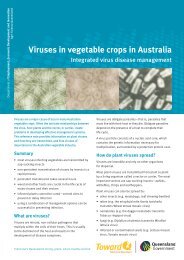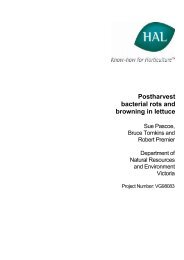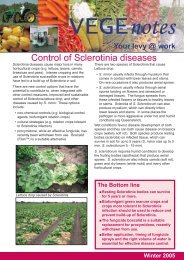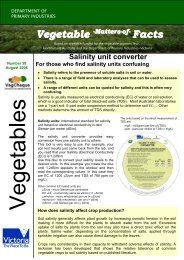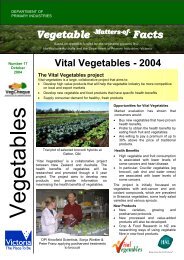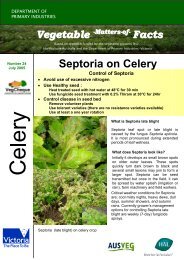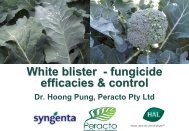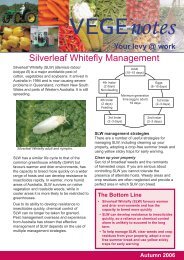Guide to Common Diseases and Disorders of Bunching Vegetables ...
Guide to Common Diseases and Disorders of Bunching Vegetables ...
Guide to Common Diseases and Disorders of Bunching Vegetables ...
You also want an ePaper? Increase the reach of your titles
YUMPU automatically turns print PDFs into web optimized ePapers that Google loves.
<strong>Guide</strong> <strong>to</strong><br />
<strong>Common</strong><br />
<strong>Diseases</strong> <strong>and</strong><br />
<strong>Disorders</strong> <strong>of</strong><br />
<strong>Bunching</strong><br />
<strong>Vegetables</strong> in<br />
Australia<br />
Narelle Kita, Elizabeth Minchin<strong>to</strong>n,<br />
Craig Murdoch <strong>and</strong> Simone Kreidl.<br />
2
<strong>Guide</strong> <strong>to</strong> <strong>Common</strong> <strong>Diseases</strong> <strong>and</strong><br />
<strong>Disorders</strong> <strong>of</strong> <strong>Bunching</strong> <strong>Vegetables</strong><br />
in Australia<br />
Narelle Kita<br />
Elizabeth Minchin<strong>to</strong>n<br />
Craig Murdoch<br />
Simone Kreidl<br />
Primary Industries Research Vic<strong>to</strong>ria<br />
Knoxfield
National Library <strong>of</strong> Australia<br />
Cataloguing-in-Publication Data<br />
Kita, N. <strong>Guide</strong> <strong>to</strong> <strong>Common</strong> <strong>Diseases</strong> <strong>and</strong> <strong>Disorders</strong> in<br />
<strong>Bunching</strong> <strong>Vegetables</strong> in Australia<br />
ISBN 174106 673 5<br />
Front cover: Spring onion field in Vic<strong>to</strong>ria.<br />
Back cover: Portable picking shed on an A-frame.<br />
Disclaimer:<br />
The advice provided in this publication is intended as a<br />
source <strong>of</strong> information only. Always read the label before<br />
using any <strong>of</strong> the products mentioned. The State <strong>of</strong> Vic<strong>to</strong>ria<br />
<strong>and</strong> its employees do not guarantee that the publication is<br />
without flaw <strong>of</strong> any kind, or is wholly appropriate for your<br />
particular purposes <strong>and</strong> therefore, disclaims all liability<br />
for any error, loss or other consequence that may arise<br />
from you relying on any information in this publication.<br />
© State <strong>of</strong> Vic<strong>to</strong>ria, Department <strong>of</strong> Primary Industries, 2003.<br />
2
ACKNOWLEDGEMENTS<br />
The authors thank Crop Health Services, Department <strong>of</strong><br />
Primary Industries (DPI) Knoxfield, Vic<strong>to</strong>ria for identification<br />
<strong>of</strong> diseases, Chemical St<strong>and</strong>ards Branch for assistance<br />
with the identification <strong>of</strong> registered chemicals <strong>and</strong> Ms<br />
Denise Wite for desk-<strong>to</strong>p publishing.<br />
In addition we thank David Farmer Pho<strong>to</strong>graphics for some<br />
<strong>of</strong> the pho<strong>to</strong>graphy <strong>and</strong> Peter Carr, Martin Meblads <strong>and</strong><br />
Grey Harrison for reading the text.<br />
We thank the steering committee <strong>of</strong> Horticulture Australia<br />
Limited project VG01045, Craig Arnott, Peter Cochran,<br />
Ge<strong>of</strong>f Foster, Rocky <strong>and</strong> Tony Lamattina, Brian Odell <strong>and</strong><br />
Karl Riedel for their helpful discussion on the contents <strong>of</strong><br />
the publication.<br />
We also thank the bunching line growers who gave us<br />
access <strong>to</strong> their crops <strong>to</strong> survey for diseases <strong>and</strong> <strong>to</strong> collect<br />
diseased plant material.<br />
We gratefully acknowledge financial support from;<br />
Horticulture Australia Limited, the <strong>Bunching</strong> Vegetable<br />
Group <strong>of</strong> the Vegetable Industry <strong>and</strong> DPI, Vic<strong>to</strong>ria, for this<br />
publication.<br />
3
CONTENTS<br />
ACKNOWLEDGEMENTS................................................. 3<br />
INTRODUCTION............................................................... 6<br />
Management strategy tips ................................................... 7<br />
BOK CHOY / PAK CHOY .................................................. 9<br />
Phoma leaf spot ...................................................................... 9<br />
White blister ......................................................................... 11<br />
BEET ................................................................................. 13<br />
Bacterial leaf spot................................................................. 13<br />
Cercospora leaf spot............................................................. 15<br />
Phoma leaf spot .................................................................... 17<br />
CORIANDER .................................................................... 19<br />
Collar <strong>and</strong> root rot ............................................................... 19<br />
DUTCH CARROTS ......................................................... 21<br />
Alternaria leaf blight............................................................ 21<br />
PARSLEY .......................................................................... 23<br />
Celery mosaic virus.............................................................. 23<br />
Leaf blight (rust) .................................................................. 25<br />
Leaf drop............................................................................... 27<br />
RADISH ............................................................................ 29<br />
White blister (rust)............................................................... 29<br />
SEEDLINGS ..................................................................... 31<br />
Damping <strong>of</strong>f .......................................................................... 31<br />
SPINACH .......................................................................... 33<br />
Downy mildew ...................................................................... 33<br />
4
SPRING ONIONS............................................................. 35<br />
Bacterial spot ........................................................................ 35<br />
Chimera................................................................................. 37<br />
Downy mildew ...................................................................... 39<br />
Fusarium basal plate rot...................................................... 41<br />
Hail damage.......................................................................... 42<br />
Herbicide damage................................................................. 43<br />
Iris Yellow Spot Virus.......................................................... 45<br />
Leaf blight............................................................................. 47<br />
Purple blotch ........................................................................ 49<br />
Rust........................................................................................ 51<br />
White rot ............................................................................... 53<br />
REFERENCES:................................................................ 54<br />
APPENDIX: ...................................................................... 55<br />
5
INTRODUCTION<br />
This h<strong>and</strong>book is part <strong>of</strong> the project titled ‘Disease<br />
management strategies for bunching vegetable growers’<br />
[Project VG01045] sponsored by the National Vegetable<br />
Levy, Horticulture Australia Limited <strong>and</strong> the Department <strong>of</strong><br />
Primary Industries, Knoxfield, Vic<strong>to</strong>ria.<br />
The diseases <strong>and</strong> disorders listed in this book are those<br />
which commonly occur on bunching vegetables in<br />
Australia. Many diseases have not been mentioned<br />
because they are either uncommon, or have not been<br />
recorded in Australia. The Appendix contains a list <strong>of</strong><br />
diseases recorded on bunching vegetable lines in Australia.<br />
It should not be used for quarantine purposes without prior<br />
checking <strong>of</strong> current references.<br />
When using this h<strong>and</strong>book it is important <strong>to</strong> realise that<br />
more than one disease can occur on plants at any one<br />
time. Also, symp<strong>to</strong>ms are <strong>of</strong>ten difficult <strong>to</strong> distinguish <strong>and</strong><br />
diagnostic tests may be required <strong>to</strong> identify pathogens<br />
accurately.<br />
Note:<br />
• The chemical information contained in this book is<br />
accurate as <strong>of</strong> June 2003.<br />
• The registration status <strong>of</strong> chemicals can change.<br />
• Always check the label prior <strong>to</strong> use.<br />
6
Management strategy tips<br />
• Where possible avoid watering plants in the evening as<br />
this may provide long hours <strong>of</strong> leaf wetness. Most<br />
spores need water <strong>to</strong> germinate <strong>and</strong> wet leaf surfaces<br />
<strong>to</strong> infect plants.<br />
• A short, heavy watering is preferable <strong>to</strong> a long, light<br />
watering. If possible avoid overhead irrigation.<br />
• Maintain good air-movement in the environment <strong>to</strong><br />
lower humidity <strong>and</strong> thus reduce spore production <strong>and</strong><br />
infection. This may mean running the rows in the<br />
direction <strong>of</strong> the wind <strong>and</strong> increasing plant spacing.<br />
• Maintain a balanced program <strong>of</strong> nutrition.<br />
• Implement/uphold good hygiene practices <strong>to</strong> avoid<br />
moving pests between properties.<br />
• Remove sources <strong>of</strong> spores, such as volunteer plants<br />
<strong>and</strong> alternative hosts.<br />
• Rotate with non-host crops <strong>and</strong> do not replant infested<br />
sites.<br />
• Avoid sequential planting as fungi can move from older<br />
crops <strong>to</strong> younger crops.<br />
• Avoid damage <strong>to</strong> the plant, as it may provide a point <strong>of</strong><br />
entry for fungi <strong>and</strong> bacteria.<br />
• Combine management practices with a registered<br />
fungicide spray program.<br />
• When applying pesticides, implement disease<br />
resistance management strategies. Alternate fungicides<br />
from different groups <strong>of</strong> chemicals <strong>to</strong> avoid fungi<br />
developing resistance <strong>to</strong> fungicides.<br />
• Control insect vec<strong>to</strong>rs with registered pesticides.<br />
• Provide staff with a clear map <strong>of</strong> the property <strong>and</strong><br />
number bays for easy identification <strong>of</strong> problem areas.<br />
7
Leaf showing Phoma lingam leaf<br />
spots.<br />
Black spore producing bodies in the<br />
centre <strong>of</strong> a Phoma lingam leaf spot.<br />
8
BOK CHOY / PAK CHOY<br />
Cause: The fungus Phoma lingam<br />
Phoma leaf spot<br />
Symp<strong>to</strong>ms:<br />
Spots on leaves are up <strong>to</strong> 2 cm in diameter, brown <strong>and</strong><br />
round <strong>to</strong> oval. Small black pimple like specks are scattered<br />
over the leaf spots but are more pronounced in its centre.<br />
The disease is more common on older, lower leaves than<br />
younger leaves. The fungus also causes a dry rot <strong>of</strong> leaf<br />
petioles <strong>and</strong> stem bases. In advanced infections plants wilt<br />
<strong>and</strong> collapse.<br />
Disease development:<br />
Infested seed is the primary means <strong>of</strong> long-distance<br />
dissemination. Spores contained in the black spots are<br />
spread locally by wind, rain, crop debris, irrigation water<br />
<strong>and</strong> <strong>to</strong> a lesser extent by insects. Disease development on<br />
foliage is favoured by high relative humidity <strong>and</strong><br />
temperatures <strong>of</strong> 15°C - 32°C.<br />
Note:<br />
Phoma lingam is the asexual state <strong>of</strong> Lep<strong>to</strong>sphaeria<br />
maculans which causes the disease blackleg on Crucifers.<br />
Control:<br />
• No fungicides are registered as <strong>of</strong> June 2003 for<br />
Phoma leaf spot on bok choy.<br />
• Avoid long hours <strong>of</strong> leaf wetness.<br />
9
White blisters on<br />
undersurface <strong>of</strong><br />
bok choy leaf.<br />
Bunch <strong>of</strong> bok<br />
choy showing<br />
white blister.<br />
10
Bok Choy<br />
Cause: The fungus Albugo c<strong>and</strong>ida<br />
White blister<br />
Symp<strong>to</strong>ms:<br />
Light green spots form on the upper leaf surface <strong>and</strong> white<br />
round <strong>to</strong> oval blisters develop on the corresponding lower<br />
leaf surface. Blisters consist <strong>of</strong> masses <strong>of</strong> white dust-like<br />
spores.<br />
Disease development:<br />
See Radish White Blister.<br />
Note:<br />
The fungus occurring on Brassica rapa (e.g. Chinese<br />
cabbage formerly B. chinensis <strong>and</strong> bok choy formerly B.<br />
pekinensis) has been named as Albugo c<strong>and</strong>ida Race 7<br />
<strong>and</strong> is largely confined <strong>to</strong> this genus <strong>and</strong> species.<br />
Control:<br />
• See Radish White Blister.<br />
11
12<br />
Bacterial leaf spots showing grey centres with purple margins.
BEET<br />
Bacterial leaf spot<br />
Cause: The bacterium Pseudomonas syringae<br />
Symp<strong>to</strong>ms:<br />
Bacterial leaf spots are an irregular-round shape <strong>and</strong> have<br />
a grey centre surrounded by a purple margin. Symp<strong>to</strong>ms<br />
can be easily confused with Cercospora leaf spot. The<br />
failure <strong>of</strong> fungicides <strong>to</strong> control these leaf spots also<br />
indicates that the symp<strong>to</strong>ms are consistent with bacterial<br />
leaf spots <strong>and</strong> not with fungal leaf spots.<br />
Disease development:<br />
The bacterium can be seed borne. It can survive on plants<br />
<strong>and</strong> on crop debris in the soil. The bacteria are probably<br />
spread from the soil <strong>to</strong> plants or between plants by water<br />
splash. Wounding <strong>of</strong> plants caused by insects or farming<br />
practices is probably necessary for infection. The<br />
temperature for bacterial growth ranges from 2°C – 35°C<br />
with an optimum <strong>of</strong> 25°C - 30°C.<br />
Control:<br />
• Fungicides will not control this disease.<br />
• No bactericides are registered for bacterial leaf spot on<br />
beet as <strong>of</strong> June 2003.<br />
• Avoid long hours <strong>of</strong> leaf wetness.<br />
• Avoid wounding plants.<br />
13
www.inra.fr/Internet/Products/HYP3/images/603<br />
0824.jpg<br />
Cercospora leaf spots on a red<br />
beet leaf (above), on a silver beet<br />
leaf (<strong>to</strong>p right) <strong>and</strong> close up <strong>of</strong><br />
spots (bot<strong>to</strong>m right).<br />
14
Beet<br />
Cercospora leaf spot<br />
Cause: The fungus Cercospora beticola<br />
Symp<strong>to</strong>ms:<br />
Leaf spots begin as small brown, circular flecks, <strong>and</strong> on red<br />
beet have a pronounced purple border. Under humid<br />
conditions, needle like spores can be seen, with a<br />
magnifying glass, raised up above the spot. The centres <strong>of</strong><br />
mature spots turn grey <strong>and</strong> <strong>of</strong>ten become so thin that the<br />
dead tissue drops out leaving a hole. As the disease<br />
progresses, spots increase in size <strong>and</strong> <strong>of</strong>ten coalesce<br />
producing a blighted appearance <strong>to</strong> leaves, followed by<br />
collapse <strong>of</strong> foliage.<br />
Disease development:<br />
The fungus can survive on beet seed, on weed hosts <strong>and</strong><br />
on crop debris in the soil for up <strong>to</strong> 18 months. Favourable<br />
conditions for disease development are high temperatures<br />
ranging from 25°C - 30°C with night temperatures above<br />
16°C <strong>and</strong> high humidity (90% - 95%) or long periods <strong>of</strong> leaf<br />
wetness.<br />
Hosts:<br />
Beet root, silverbeet, chard <strong>and</strong> weeds eg Atriplex.<br />
Control:<br />
• Incorporate crop debris well in<strong>to</strong> <strong>to</strong> the ground.<br />
• Establish new crops <strong>of</strong> beet well away from the<br />
previous crops eg 100m.<br />
• Chemical control: use a product containing mancozeb,<br />
registered for control <strong>of</strong> Cercospora leaf spot on beet in<br />
your state. This information is current as <strong>of</strong> June 2003.<br />
15
Close up <strong>of</strong><br />
Phoma leaf spot.<br />
Phoma leaf spot on red beet leaf.<br />
16
Beet<br />
Cause: The fungus Phoma beta<br />
Phoma leaf spot<br />
Symp<strong>to</strong>ms:<br />
Spots on leaves are up <strong>to</strong> 2 cm in diameter, brown, round<br />
<strong>to</strong> oval, with dark concentric rings near the perimeter.<br />
Small black raised dots, which contain spores, are found<br />
throughout the spots in concentric rings. Older, lower<br />
leaves are generally more susceptible <strong>to</strong> the disease than<br />
younger leaves. Phoma leaf spots are bigger in size<br />
compared with bacterial <strong>and</strong> Cercospora leaf spots.<br />
Disease development:<br />
Infested seed is the primary means <strong>of</strong> long-distance<br />
dissemination. Spores are spread locally by wind, rain,<br />
wind-blown plant debris, irrigation water <strong>and</strong> <strong>to</strong> a lesser<br />
extent, insects. Disease development on foliage is favoured<br />
by high relative humidity <strong>and</strong> temperatures <strong>of</strong> 15°C - 32°C.<br />
Control:<br />
• No fungicides are registered for Phoma leaf spot on<br />
beet as <strong>of</strong> June 2003.<br />
17
Tip rot <strong>of</strong> taproot<br />
associated with<br />
Mycocentrospora.<br />
Tap-root lesion.<br />
Collar rot with split<br />
outer root.<br />
Mycocentrospora on cori<strong>and</strong>er showing stunting,<br />
yellowing <strong>and</strong> browning <strong>of</strong> leaves <strong>and</strong> rot <strong>of</strong> roots.<br />
18
CORIANDER<br />
Collar <strong>and</strong> root rot<br />
Cause: The fungus Mycocentrospora acerina<br />
Symp<strong>to</strong>ms:<br />
Plants are stunted, older leaves turn yellow then brown.<br />
The fungus causes a brown rot <strong>of</strong> the collar <strong>and</strong> taproot,<br />
which is <strong>of</strong>ten associated with a splitting <strong>of</strong> the outer root.<br />
Pythium was also isolated from the lateral roots <strong>of</strong> the<br />
cori<strong>and</strong>er <strong>and</strong> there may be a disease complex between<br />
the two fungi.<br />
Mycocentrosppora (Centrospora) is responsible for licorice<br />
post harvest rot <strong>of</strong> carrots <strong>and</strong> collar rot <strong>of</strong> celery in cold<br />
s<strong>to</strong>rage. It also causes anthracnose lesions (leaf spot<br />
formed <strong>of</strong> dead tissue) on stems <strong>and</strong> umbels <strong>of</strong> caraway,<br />
dill <strong>and</strong> parsnip.<br />
Disease development:<br />
Spores <strong>of</strong> the fungus survive in soil <strong>and</strong> can be dispersed in<br />
irrigation water. Mechanical damage <strong>to</strong> plants can promote<br />
the disease. Rotting <strong>of</strong> roots can occur at 0°C, but the<br />
optimum temperatures for fungal growth are 17°C - 20°C.<br />
The foliage version <strong>of</strong> the disease is promoted by long<br />
periods <strong>of</strong> leaf wetness <strong>and</strong> high nitrogen levels.<br />
Control:<br />
• No fungicides are currently registered as <strong>of</strong> June 2003<br />
for Mycocentrospora on cori<strong>and</strong>er.<br />
• Avoid high plant densities.<br />
• Avoid high nitrogen levels.<br />
19
DUTCH CARROTS<br />
Cause: The fungus Alternaria<br />
Alternaria leaf blight<br />
Symp<strong>to</strong>ms:<br />
The foliage <strong>of</strong> infected crops appears scorched (blighted)<br />
from a distance. Small brown water soaked spots, <strong>of</strong>ten<br />
surrounded by a yellow halo, form initially on older leaves<br />
<strong>and</strong> petioles. These may yellow, collapse <strong>and</strong> die. This<br />
symp<strong>to</strong>m can be confused with bacterial leaf blight. The<br />
fungus also attacks seedling stems <strong>and</strong> upper roots at the<br />
soil line producing a post-emergence blight <strong>of</strong> seedlings,<br />
which is similar <strong>to</strong> damping <strong>of</strong>f, cause by Pythium. It differs<br />
from Pythium damping <strong>of</strong>f by having a drier decay <strong>of</strong><br />
infected material.<br />
Disease development:<br />
The fungus can survive on seed, volunteer carrots, wild<br />
carrots, dead <strong>and</strong> dying carrot tissue <strong>and</strong> on carrot debris in<br />
the soil for less than one year. Spores are released in the<br />
morning as the humidity drops <strong>and</strong> then disseminated by<br />
wind or farming activities. Ideal conditions for infection are<br />
prolonged hours <strong>of</strong> leaf wetness <strong>and</strong> moderately warm<br />
temperatures.<br />
Control:<br />
• Avoid long hours <strong>of</strong> leaf wetness.<br />
• A spray forecast model, based on leaf wetness <strong>and</strong><br />
temperature is available for this disease on carrots.<br />
• Contaminated seed can be treated with hot water<br />
(50°C for 20 min.) or with a fungicide seed dressing.<br />
• Chemical control: use a product containing either<br />
mancozeb, metiram, zineb or cupric hydroxide that is<br />
registered for leaf blight on carrots in your state. This<br />
information is current as <strong>of</strong> June 2003.<br />
21
Pho<strong>to</strong>graph courtesy <strong>of</strong> Violeta Taicevski Vic DPI<br />
Yellowing <strong>of</strong> young leaves on celery caused by CeMV.<br />
Pho<strong>to</strong>graph courtesy <strong>of</strong> Violeta<br />
Taicevski Vic DPI<br />
CeMV on cori<strong>and</strong>er.<br />
Pho<strong>to</strong>graph courtesy <strong>of</strong> Violeta Taicevski<br />
Vic DPI<br />
CeMV on parsley.<br />
22
PARSLEY<br />
Cause: The celery mosaic virus (CeMV)<br />
Celery mosaic virus<br />
Symp<strong>to</strong>ms:<br />
On young leaves the virus causes vein clearing <strong>and</strong> a<br />
yellow or light green coloured inter-veinal mottling. On<br />
mature foliage leaflets are narrow, twisted <strong>and</strong> mottled.<br />
Plants may be slightly stunted.<br />
Disease development:<br />
CeMV is not seedborne. The virus can be transmitted<br />
mechanically by farming practices <strong>and</strong> by many species <strong>of</strong><br />
aphids, after they feed on an infected plant for 5 <strong>to</strong> 30<br />
seconds. Sources <strong>of</strong> the virus are umbelliferous crop plants<br />
such as celery, carrot <strong>and</strong> dill as well as umbelliferous<br />
weeds. Sequential or overlapping crops are considered <strong>to</strong><br />
be the most important source <strong>of</strong> the virus.<br />
Control:<br />
• Remove weed hosts.<br />
• In severe infections implement a host-free period for<br />
1 <strong>to</strong> 3 months.<br />
• Fungicides will not control viral diseases.<br />
23
24<br />
Leaves <strong>of</strong> flat parsley<br />
(above) <strong>and</strong> curly parsley<br />
(left) showing Sep<strong>to</strong>ria<br />
leaf blight.
Parsley<br />
Cause: The fungus Sep<strong>to</strong>ria petroselini<br />
Leaf blight (rust)<br />
Symp<strong>to</strong>ms:<br />
Small round-shaped lesions, greyish brown in colour<br />
surrounded by a dark brown <strong>to</strong> red margin are produced on<br />
the leaf surface <strong>and</strong> occasionally on the petioles. As the<br />
disease progresses, the foliar tissue becomes yellow <strong>and</strong><br />
finally dies.<br />
Disease development:<br />
The disease cycle <strong>and</strong> epidemiology <strong>of</strong> this pathogen is not<br />
well unders<strong>to</strong>od. However, the fungus can be seed-borne,<br />
<strong>and</strong> losses <strong>of</strong> both yield <strong>and</strong> quality have been reported.<br />
The fungus may over-winter on diseased parsley plants. It<br />
is spread by wind, rain, irrigation water <strong>and</strong> workers <strong>and</strong><br />
machinery moving through wet foliage. The disease occurs<br />
on both flat <strong>and</strong> curly parsley.<br />
Note:<br />
The disease is <strong>of</strong>ten called rust by growers, but it is not<br />
caused by a true rust fungus.<br />
Control:<br />
• Avoid long periods <strong>of</strong> leaf wetness.<br />
• No fungicides are currently registered for Sep<strong>to</strong>ria leaf<br />
blight on parsley as <strong>of</strong> June 2003.<br />
25
Rot <strong>of</strong> lower taproot.<br />
Pho<strong>to</strong>graph courtesy <strong>of</strong> Julia Telford, IDO <strong>Vegetables</strong><br />
Qld.<br />
Wilt, drop <strong>and</strong> bleaching <strong>of</strong> parsley<br />
leaves above <strong>and</strong> rot <strong>of</strong> taproot<br />
below, caused by Erwinia.<br />
26<br />
Pho<strong>to</strong>graph courtesy <strong>of</strong> Julia Telford, IDO <strong>Vegetables</strong> Qld.
Parsley<br />
Leaf drop<br />
Cause: The bacterium Erwinia.<br />
Symp<strong>to</strong>ms:<br />
Infected plants may be stunted. Leaves wilt, drop <strong>to</strong> the<br />
ground around the shoot <strong>and</strong> turn white. A s<strong>of</strong>t watery rot <strong>of</strong><br />
the taproots occurs along their length making it difficult <strong>to</strong><br />
remove the root system intact.<br />
Disease development:<br />
Little is known <strong>of</strong> this disease on parsley. The bacterium is<br />
ubiqui<strong>to</strong>us in soils. It most likely survives in crop debris in<br />
the soil <strong>and</strong> is common in surface water sources. Bacteria<br />
enter plants through wounds <strong>and</strong> natural openings. Leaf<br />
drop <strong>and</strong> its associated root rot appear <strong>to</strong> be triggered by<br />
warm temperatures, excessive soil moisture <strong>and</strong> or<br />
mechanical damage <strong>to</strong> roots.<br />
The pho<strong>to</strong>graphs opposite show leaf drop on parsley in the<br />
tropics after 6 weeks <strong>of</strong> rain. It is not known if the bacterium<br />
Erwinia is the primary or secondary cause <strong>of</strong> parsley leaf<br />
drop.<br />
Control:<br />
• No bactericides are currently registered for leaf drop on<br />
parsley as <strong>of</strong> June 2003.<br />
• Avoid over irrigation <strong>of</strong> soil.<br />
27
28<br />
White blisters on underside<br />
<strong>of</strong> radish leaf (above) <strong>and</strong><br />
on the upperside <strong>of</strong> a leaf<br />
(left).
RADISH<br />
Cause: The fungus Albugo c<strong>and</strong>ida<br />
White blister (rust)<br />
Symp<strong>to</strong>ms:<br />
Yellow <strong>to</strong> brown spots form on the upper surface <strong>and</strong> white,<br />
round <strong>to</strong> oval blisters develop on the corresponding under<br />
leaf surface. The blisters consist <strong>of</strong> masses <strong>of</strong> white dustlike<br />
spores. Badly infected leaves will initially become<br />
misshapen, then wilt <strong>and</strong> die.<br />
Disease development:<br />
The fungus can survive on seed <strong>and</strong> in crop debris as<br />
oospores. Spores produced on the underside <strong>of</strong> leaves<br />
survive for only a few days <strong>and</strong> are spread by wind, rain<br />
<strong>and</strong> insects. Spores germinate over the temperature range<br />
<strong>of</strong> 1°C - 20°C. Water in the form <strong>of</strong> dew, fog or rain on<br />
leaves, combined with temperatures in the range from 10°C<br />
- 25°C favour disease development. The fungus can<br />
release its spores <strong>and</strong> infect plants at anytime <strong>of</strong> the day or<br />
night. The optimum conditions for disease development are<br />
3 hours <strong>of</strong> leaf wetness at 20°C.<br />
Control:<br />
• No fungicides are currently registered for white blister<br />
on radish, however Crop Protection Approvals are<br />
currently conducting work with a view <strong>to</strong> registration <strong>of</strong><br />
fungicides.<br />
• Avoid long hours <strong>of</strong> leaf wetness by not irrigating at<br />
night (8pm-12pm).<br />
Note: Albugo c<strong>and</strong>ida Race 1 occurs on Raphanus sativa<br />
<strong>and</strong> is largely confined <strong>to</strong> this genus.<br />
29
Parsley seedlings showing damping <strong>of</strong>f.<br />
30
SEEDLINGS<br />
Cause: The fungus Pythium spp.<br />
Damping <strong>of</strong>f<br />
Symp<strong>to</strong>ms:<br />
There are two forms <strong>of</strong> damping <strong>of</strong>f, pre-emergence <strong>and</strong><br />
post-emergence. The symp<strong>to</strong>ms <strong>of</strong> pre-emergence<br />
damping <strong>of</strong>f are poor crop emergence due <strong>to</strong> lack <strong>of</strong> seed<br />
germination or seed germinating but seedlings failing <strong>to</strong><br />
emerge. Post-emergence damping <strong>of</strong>f symp<strong>to</strong>ms can<br />
consist <strong>of</strong> seedlings bending over at a 90° angle <strong>to</strong> the<br />
ground, roots turning dark brown, plants appearing stunted<br />
<strong>and</strong> taproots developing dark patches with laterals <strong>of</strong>ten<br />
missing. As the disease progresses leaves turn yellow <strong>and</strong><br />
eventually die back. Younger plants are more susceptible.<br />
Badly affected plants may eventually die.<br />
Disease development:<br />
The pathogen can survive for long periods in the soil due <strong>to</strong><br />
the thick-walled structure <strong>of</strong> the spore. Plant roots produce<br />
exudates under favourable conditions, such as high levels<br />
<strong>of</strong> soil moisture, <strong>and</strong> this triggers germination <strong>of</strong> the soilborne<br />
spores. The disease can be spread in water,<br />
infecting neighbouring plant roots.<br />
Host Range:<br />
Most seedlings eg. carrot, cori<strong>and</strong>er, radish, spring onions<br />
or shallots.<br />
Control:<br />
• Plant in<strong>to</strong> well drained ground.<br />
• No fungicides are currently registered, as <strong>of</strong> June 2003,<br />
for damping <strong>of</strong>f on vegetables.<br />
• Fumigation, as a pre-plant treatment is an option for<br />
controlling soil borne diseases.<br />
31
Under surface <strong>of</strong> spinach leaves with downy mildew.<br />
32
SPINACH<br />
Downy mildew<br />
Cause: The fungus Peronospora farinosa f. sp. spinaciae<br />
Symp<strong>to</strong>ms:<br />
The disease begins as indefinite yellowish areas on the<br />
upper leaf surface with a corresponding greyish-violet mat<br />
on the lower leaf surface. As the disease develops the<br />
lesions enlarge until the whole leaf is affected, at which<br />
point it will turn black <strong>and</strong> die. During wet weather, the<br />
infected leaves become water soaked, quickly change <strong>to</strong> a<br />
yellow-brown colour <strong>and</strong> rot. Plants that survive infection<br />
are usually stunted in growth <strong>and</strong> leaves have a creamyyellow<br />
<strong>and</strong> wrinkled appearance.<br />
Disease development:<br />
The pathogen is able <strong>to</strong> over-winter in living plants, in seed<br />
for two years <strong>and</strong> in the soil for about one year.<br />
Germination requires wet leaf surfaces <strong>and</strong> a temperature<br />
<strong>of</strong> about 9°C. A period <strong>of</strong> 6-7 days at 70-90% relative<br />
humidity <strong>and</strong> 16-24°C is required from the time <strong>of</strong> infection<br />
until spores are produced. Spores produced on leaves<br />
survive for about 2 days <strong>and</strong> may lose viability when<br />
exposed <strong>to</strong> sunlight.<br />
Control:<br />
• Chemical control: use a product containing either<br />
copper oxychloride, copper hydroxide, tribasic copper<br />
sulfate, copper as cupric hydroxide or mancozeb that is<br />
registered for control <strong>of</strong> downy mildew on spinach in<br />
your state. This information is current as <strong>of</strong> June 2003.<br />
• Avoid long periods <strong>of</strong> leaf wetness.<br />
33
•<br />
Grey spots or streaking<br />
surrounded by brown margins<br />
with a wet appearance.<br />
Plants showing dieback <strong>of</strong> older leaves <strong>and</strong><br />
yellowing <strong>of</strong> central leaf.<br />
34
SPRING ONIONS<br />
Cause: The bacteria Pseudomonas syringae<br />
Bacterial spot<br />
Symp<strong>to</strong>ms:<br />
Infected tissues develop lesions, which are pale yellow <strong>to</strong><br />
light brown in colour <strong>and</strong> have a water-soaked appearance<br />
around the margins. As the disease develops, the lesions<br />
elongate <strong>to</strong> an oval shape. Lesions may fuse <strong>to</strong>gether as<br />
multiple infection sites, affecting whole leaves causing the<br />
outer leaves <strong>to</strong> wither <strong>and</strong> die. The youngest leaf on an<br />
infected plant turns a lemon <strong>to</strong> light green colour.<br />
Disease development:<br />
Bacteria enter plants through wounds or natural openings.<br />
The disease is most common in areas <strong>of</strong> high rainfall or in<br />
wet spots caused by excessive overhead irrigation, or in<br />
association with mechanical injury caused by overcrowding,<br />
barnyard grass, machinery or workers. Significant crop<br />
losses have been reported during summer in Vic<strong>to</strong>ria but<br />
the disease can also be found at low levels during winter.<br />
Note: The bacterium also infects leeks causing bacterial<br />
blight, which appears as a brown streaking on the shank.<br />
Control:<br />
• Avoid excessive overhead irrigation.<br />
• Remove barnyard grass (Echinochloa crus-galli <strong>and</strong> E.<br />
colona) from crops.<br />
• No bactericides are registered for bacterial spot on<br />
spring onions, as <strong>of</strong> June 2003.<br />
35
Yellow <strong>and</strong> green striping on foliage <strong>of</strong> a chimera<br />
affect spring onion<br />
36
Spring Onions<br />
Chimera<br />
Cause: Genetic abnormality<br />
Symp<strong>to</strong>ms:<br />
Often confused with symp<strong>to</strong>ms induced by plant pathogens<br />
or abiotic fac<strong>to</strong>rs, chimeras are leaf variegations, which<br />
may appear as linear or mosaic patterns <strong>of</strong> green, yellow,<br />
or white tissue. Variegation may be expressed on individual<br />
leaves or whole plants <strong>and</strong> may affect the development <strong>of</strong><br />
the plant.<br />
They occur during cell division when all the chloroplasts<br />
stay in one daughter cell instead <strong>of</strong> being distributed<br />
between the two daughter cells. The cultivar Paragon <strong>of</strong>ten<br />
throws a chimera plant.<br />
37
Grey-violet growth <strong>of</strong><br />
early downy mildew.<br />
38<br />
Leaves infected with downy<br />
mildew curl downward.
Spring Onions<br />
Downy mildew<br />
Cause: The fungus Peronospora destruc<strong>to</strong>r<br />
Symp<strong>to</strong>ms:<br />
Downy mildew first appears on leaves as pale green,<br />
elongate patches, which develop a greyish-violet, furry<br />
growth containing spores <strong>and</strong> spore-producing structures.<br />
Later, unreleased spores turn black <strong>and</strong> other fungi, such<br />
as Alternaria or Stemphylium may invade lesions. Infected<br />
leaves curl downward, shrivel, collapse <strong>and</strong> die.<br />
Disease development:<br />
Severe disease outbreaks occur with cool foggy weather<br />
<strong>and</strong> dewy nights. Spores are produced on foliage overnight<br />
<strong>and</strong> released during the morning. These spores can survive<br />
for 1 <strong>to</strong> 3 days <strong>and</strong> are spread by wind <strong>and</strong> rain splash. The<br />
fungus is not considered <strong>to</strong> be seed-borne in spring onions.<br />
Dry weather with relative humidity less than 80% <strong>and</strong><br />
temperatures less than 4°C or greater than 24°C inhibits<br />
fungal growth.<br />
Control:<br />
• An increase in potash (K) has been shown <strong>to</strong> reduce<br />
the susceptibility <strong>of</strong> onions <strong>to</strong> downy mildew.<br />
• Avoid overhead irrigating especially from 8pm - 12pm.<br />
• Chemical control: use a product containing either<br />
mancozeb, copper ammonium acetate, copper<br />
oxychloride, cuprous oxide, cupric (II) hydroxide,<br />
mancozeb <strong>and</strong> cupric (II) hydroxide, mancozeb <strong>and</strong><br />
metalaxyl-M, mancozeb <strong>and</strong> metalaxyl, dimethomorph,<br />
dimethomorph <strong>and</strong> mancozeb, zineb <strong>and</strong> propineb or<br />
benalaxyl <strong>and</strong> mancozeb, that is registered for control<br />
<strong>of</strong> downy mildew on spring onions (shallots) in your<br />
state. This information is current as <strong>of</strong> June 2003.<br />
39
40<br />
Basal plate rot on spring onion seedlings.
Spring Onions<br />
Fusarium basal plate rot<br />
Cause: The fungus Fusarium oxysporum<br />
Symp<strong>to</strong>ms:<br />
The disease first appears as curving, yellowing <strong>and</strong> death<br />
<strong>of</strong> leaf tips, which progresses downwards. The basal stem<br />
plate may show a brown discolouration, root growth is<br />
sparse, <strong>and</strong> infected plants may wilt. Plants eventually rot<br />
leaving bare patches in the crop. Plants can be affected at<br />
any age.<br />
Disease development:<br />
The fungus is commonly found in soils where onions are<br />
grown <strong>and</strong> where soil temperatures do not fall below 15°C.<br />
The optimum soil temperatures for disease development<br />
are 25°C - 28°C. Mechanical or insect injury increases<br />
incidence <strong>of</strong> the disease. Spores are present in the soil <strong>and</strong><br />
machinery is a common means <strong>of</strong> spore dissemination.<br />
Control:<br />
• No fungicides are registered for Fusarium basal plate<br />
rot on onions, as at June 2003.<br />
• Avoid mechanical or insect injury <strong>to</strong> plants.<br />
• Avoid over-irrigation <strong>of</strong> soil.<br />
41
Spring Onions<br />
Hail damage<br />
Cause:<br />
Plants are <strong>of</strong>ten damaged during strong winds <strong>and</strong> s<strong>to</strong>rms<br />
as soil particles, wind-driven s<strong>and</strong>, hails<strong>to</strong>nes <strong>and</strong> raindrops<br />
strike <strong>and</strong> injure the exposed leaves.<br />
Symp<strong>to</strong>ms:<br />
Damage is usually limited <strong>to</strong> the side <strong>of</strong> the plant, which<br />
was physically impacted. Symp<strong>to</strong>ms consist <strong>of</strong> pale yellow<br />
or white spots or flecks. Injury sites may vary in size <strong>and</strong><br />
shape <strong>and</strong> are a key entry point for fungi <strong>and</strong> bacteria.<br />
Hail damage on leaves.<br />
42
Spring Onions<br />
Herbicide damage<br />
Cause:<br />
Temporary or permanent damage can result from the<br />
improper use <strong>of</strong> herbicides. The most common causes<br />
include:<br />
• Carryover <strong>of</strong> chemical residues<br />
• Application at excessive rates<br />
• Application at the incorrect stage <strong>of</strong> plant development<br />
• Improper mixtures or concentrations <strong>of</strong> adjuvants.<br />
Symp<strong>to</strong>ms:<br />
Symp<strong>to</strong>ms <strong>of</strong> herbicide damage can consist <strong>of</strong> sunken,<br />
white, bleached or dead spots, atypical plant growth (leaf<br />
curling or twisting) or tip die-back. Generally, plants with<br />
herbicide injury recover, <strong>and</strong> symp<strong>to</strong>ms do not appear on<br />
new growth.<br />
Herbicide<br />
damage on<br />
spring onion<br />
leaves.<br />
43
http://plant-disease.ippc.orst.edu/disease.cfm?RecordID=1368<br />
Field <strong>of</strong> bulb onions with IYSV (above).<br />
http://www.colostate.edu/Depts/CoopExt/TRA/PLANTA/iysv.html<br />
Close up <strong>of</strong> some IYSV symp<strong>to</strong>ms.<br />
44
Spring Onions<br />
Cause: Iris Yellow Spot Virus<br />
Iris Yellow Spot Virus<br />
Symp<strong>to</strong>ms:<br />
The disease appears as straw-coloured, dry, diamondshaped<br />
lesions on the leaves <strong>of</strong> onion plants. Some lesions<br />
appear as concentric rings <strong>of</strong> alternating green <strong>and</strong><br />
yellow/tan tissue, while others have distinct green centres<br />
with yellow or tan borders. Tops <strong>of</strong> infected plants turn<br />
brown, die <strong>and</strong> fall over. Infected plants may be scattered<br />
throughout a field or the whole crop can be infected.<br />
Disease development:<br />
Tospoviruses are only spread by onion thrips. Western<br />
flower thrips are not known <strong>to</strong> carry this virus. The IYS virus<br />
is not seed borne <strong>and</strong> does not carry over in the soil. It<br />
does not move from the leaves in<strong>to</strong> the bulb or roots.<br />
Volunteer plants from a previous season can carry the<br />
virus. A survey <strong>of</strong> Vic<strong>to</strong>rian spring onion crops during<br />
summer <strong>and</strong> autumn <strong>of</strong> 2003 did not detect the disease.<br />
Control:<br />
• Remove volunteer plants.<br />
• Control onion thrips.<br />
• Do not apply fungicides, as they will not control this viral<br />
disease.<br />
45
46<br />
Olive brown lesions <strong>of</strong><br />
Stemphylium leaf blight<br />
covered in black spores.
Spring Onions<br />
Leaf blight<br />
Cause: The fungus Stemphylium vesicarium sp.<br />
Symp<strong>to</strong>ms:<br />
This fungus is usually found co-infecting with Alternaria<br />
porri <strong>and</strong> symp<strong>to</strong>ms are very similar <strong>to</strong> purple blotch.<br />
However, Stemphylium leaf blight lesions appear <strong>to</strong> be a<br />
darker, more olive-brown <strong>to</strong> black in colour than purple<br />
blotch lesions. Lesions have a water-soaked appearance<br />
<strong>and</strong> are initially small <strong>and</strong> light yellow <strong>to</strong> brown in colour.<br />
Lesions <strong>of</strong>ten coalesce in<strong>to</strong> long patches, which may reach<br />
the leaf tips. These lesions turn a dark brown <strong>to</strong> black<br />
colour when spores are produced.<br />
Disease development:<br />
The fungus normally invades dead, dying or injured onion<br />
tissue i.e. dead leaf tips, purple blotch <strong>and</strong> downy mildew<br />
lesions. Lesions are most <strong>of</strong>ten seen on the side <strong>of</strong> the leaf<br />
facing the prevailing wind. Optimum conditions for disease<br />
development are warm, rainy weather, lasting for more than<br />
24 hours. This fungus causes only minimal damage when<br />
plants are healthy.<br />
Control:<br />
• Maintain a balanced program <strong>of</strong> nutrition.<br />
• Avoid long hours <strong>of</strong> leaf wetness.<br />
• No chemicals are registered for Stemphylium leaf blight<br />
on spring onions, as at June 2003.<br />
47
www.plantpathology.tamu.edu/Texlab/<strong>Vegetables</strong>/onions/opb.htm<br />
Purple blotch<br />
48
Spring Onions<br />
Cause: The fungus Alternaria porri<br />
Purple blotch<br />
Symp<strong>to</strong>ms:<br />
Lesions first develop on older leaves as small water-soaked<br />
spots, which rapidly develop white centres. They quickly<br />
enlarge <strong>and</strong> develop a purple margin surrounded by a<br />
yellow zone that extends along the leaf. Concentric light<br />
<strong>and</strong> dark zones later appear over the purple area. Under<br />
moist conditions brown spores develop on the lesion<br />
surface. Infected leaves will <strong>of</strong>ten turn yellow <strong>and</strong> droop,<br />
<strong>and</strong> in severe cases exhibit dieback.<br />
Disease development:<br />
This disease can quickly spread. The optimum temperature<br />
for fungal growth is 25°C with a range <strong>of</strong> 6°C - 34°C.<br />
Spores are produced at night when relative humidity is<br />
greater than 90%. They are released in<strong>to</strong> the atmosphere<br />
during the early morning (7am-10am) <strong>and</strong> dispersed by<br />
wind, rain, irrigation <strong>and</strong> spray operations. Purple blotch<br />
symp<strong>to</strong>ms appear 1-4 days after infection. The fungus can<br />
survive on seed <strong>and</strong> in crop debris. The former is<br />
considered unimportant for fungal dispersal.<br />
Control:<br />
• Avoid long hours <strong>of</strong> leaf wetness.<br />
• Chemical control: Use a product containing either<br />
mancozeb, mancozeb/copper as cupric hydroxide,<br />
zineb,. dimethomorph, dimethomorph/mancozeb,<br />
mancozeb/metalaxyl, mancozeb/metalaxyl-M or<br />
benalaxyl/mancozeb that is registered for purple blotch<br />
on spring onions in your state. This information is<br />
current as <strong>of</strong> June 2003.<br />
49
Yellow rust pustles on leaves typical <strong>of</strong> early season symp<strong>to</strong>ms.<br />
Pho<strong>to</strong>graph courtesy <strong>of</strong> Dean Metcalf DPIWE Tasmania<br />
Black rust pustles, typical <strong>of</strong> late season symp<strong>to</strong>ms.<br />
50
Spring Onions<br />
Rust<br />
Cause: The fungus Puccinia allii<br />
Symp<strong>to</strong>ms:<br />
Early symp<strong>to</strong>ms are small white <strong>to</strong> yellow spots or flecks on<br />
leaves that turn yellow <strong>to</strong> orange as spores are produced in<br />
the leaf tissue. Later in the season, dark brown <strong>to</strong> black<br />
spores may form in the pustules. Heavily infected leaves<br />
turn yellow <strong>and</strong> may collapse prematurely.<br />
Disease development:<br />
Weather conditions conducive <strong>to</strong> outbreaks <strong>of</strong> rust are low<br />
rainfall, 100% relative humidity <strong>and</strong> temperatures in the<br />
range <strong>of</strong> 10°C - 15°C. While temperatures above 24°C <strong>and</strong><br />
below 10°C inhibit the fungus. Stressed plants eg. those<br />
that are <strong>to</strong>o wet or <strong>to</strong>o dry, or those exposed <strong>to</strong> excessive<br />
nitrogen are more susceptible <strong>to</strong> the disease.<br />
Control:<br />
• Avoid excessive nitrogen.<br />
• Maintain a balanced irrigation regime <strong>and</strong> avoid<br />
conditions which are <strong>to</strong>o wet or <strong>to</strong>o dry.<br />
• Avoid growing onion <strong>and</strong> leek crops in the same<br />
vicinity.<br />
• No fungicides are currently registered, as <strong>of</strong> June 2003,<br />
for rust (P. allii) on spring onions.<br />
51
52<br />
Close up <strong>of</strong> white rot on spring onions (<strong>to</strong>p) <strong>and</strong> in a<br />
field (above).
Spring Onions<br />
Cause: The fungus Sclerotium cepivorum<br />
White rot<br />
Symp<strong>to</strong>ms:<br />
The first above ground symp<strong>to</strong>ms are a yellowing <strong>and</strong><br />
dieback <strong>of</strong> the leaf tips, followed by a collapse <strong>of</strong> the<br />
affected leaves. A s<strong>of</strong>t rot gradually destroys the roots<br />
making the plants easy <strong>to</strong> uproot. A white, fluffy mould (the<br />
fungal mycelium) forms on roots <strong>and</strong> masses <strong>of</strong> tiny black<br />
spherical bodies (sclerotia) form within it. Plants tend <strong>to</strong> die<br />
out in patches.<br />
Disease development:<br />
The sclerotia enable the fungus <strong>to</strong> remain dormant in the<br />
soil for 30 years or more, even in the absence <strong>of</strong> onion<br />
plants. Disease severity depends on sclerotia levels in the<br />
soil at planting. Disease can be initiated by one sclerotium<br />
per 10 kg <strong>of</strong> soil <strong>and</strong> 10-20 sclerotia per kg <strong>of</strong> soil can result<br />
in infection <strong>of</strong> all plants. Cool soil conditions (14°C – 19°C)<br />
<strong>and</strong> low moisture favour disease development. The disease<br />
spreads from plant <strong>to</strong> plant through root contact. Plant<br />
losses become more widespread with each subsequent<br />
planting <strong>of</strong> an Allium crop. Sclerotia spread the disease<br />
quickly in the field by workers, <strong>to</strong>ols, machinery, or run-<strong>of</strong>f<br />
water.<br />
Control:<br />
• Implement good hygiene practices.<br />
• Chemical control: use a product containing<br />
procymidone that is registered for control <strong>of</strong> white rot on<br />
spring onions in your state. Note it can be registered as<br />
either a seed treatment, in furrow treatment or as a soil<br />
spray. This information is current as <strong>of</strong> June 2003.<br />
53
•<br />
REFERENCES:<br />
Cook, R.P. <strong>and</strong> Dube, A.J. (1989). Host-pathogen index <strong>of</strong> plant<br />
disease in South Australia. South Australian Department<br />
<strong>of</strong> Agriculture, 142pp.<br />
Davis, R.M. <strong>and</strong> Raid, R.N. (Edts.) (2002). Compendium <strong>of</strong><br />
umbelliferous crop diseases. The American<br />
Phy<strong>to</strong>pathological Society, 75pp.<br />
Howard, R.J., Garl<strong>and</strong>, J. <strong>and</strong> Seaman, W.L. Edts. (1994).<br />
Disease <strong>and</strong> pests <strong>of</strong> vegetable crops in Canada. The<br />
Canadian Phy<strong>to</strong>pathological Society <strong>and</strong> En<strong>to</strong>mological<br />
Society <strong>of</strong> Canada, 554pp.<br />
Persley, D. (Edt). (1994). <strong>Diseases</strong> <strong>of</strong> vegetable crops.<br />
Department <strong>of</strong> Primary Industries Queensl<strong>and</strong>, 100pp.<br />
Pitkethley, R.N. (1970). A preliminary list <strong>of</strong> plant disease in the<br />
Northern Terri<strong>to</strong>ry. Technical Bulletin No. 2, Primary<br />
Industries Branch, Northern Terri<strong>to</strong>ry Administration,<br />
Darwin, 30pp.<br />
Sampson, P.J. <strong>and</strong> Walker, J. (1982). An annotated list <strong>of</strong> plant<br />
disease in Tasmania. Department <strong>of</strong> Agriculture,<br />
Tasmania, 121pp.<br />
Schwartz, H.F. <strong>and</strong> Mohan, S.K. (Edts.) (1999). Compendium <strong>of</strong><br />
onion <strong>and</strong> garlic diseases. The American<br />
Phy<strong>to</strong>pathological Society, 3rd printing, 54pp.<br />
Sherf, A.F. <strong>and</strong> Macnab, A.A. (1986). Vegetable disease <strong>and</strong><br />
their control. 2nd Edt. John Wiley & Sons. Inc., 728pp.<br />
Shivas, R.G. (1989). Fungal <strong>and</strong> bacterial disease <strong>of</strong> plants in<br />
Western Australia. Journal <strong>of</strong> the Royal Society <strong>of</strong><br />
Western Australia. 72, 62pp.<br />
Washing<strong>to</strong>n, W.S. <strong>and</strong> Nancarrow, R.J. (1980). List <strong>of</strong> disease<br />
recorded on fruit <strong>and</strong> vegetable crops in Vic<strong>to</strong>ria before<br />
June 30, 1980. Department <strong>of</strong> Agriculture, Vic<strong>to</strong>ria,<br />
Technical Report No. 66. 51pp.<br />
Whitney, E.D. <strong>and</strong> Duffus, J.E. (Edts.) (1998). Compendium <strong>of</strong><br />
beet disease <strong>and</strong> insects. The American<br />
Phy<strong>to</strong>pathological Society, 3 rd printing, 76pp.<br />
54
APPENDIX:<br />
Index <strong>of</strong> pathogens on bunching vegetables<br />
Host scientific<br />
name<br />
Host common<br />
name<br />
Pathogen<br />
Disease<br />
Allium cepa bulb onion Alternaria alternata black bulb scale leaf<br />
Alternaria porri<br />
purple blotch<br />
Aspergillus niger<br />
black mould<br />
Botrytis allii<br />
neck rot<br />
Botrytis cinerea<br />
foliage blight<br />
Botrytis squamosa<br />
neck rot <strong>and</strong> foliage blight<br />
Collecocrichum circianans<br />
smudge<br />
Colle<strong>to</strong>trichum dematium<br />
smudge<br />
Erwinia caro<strong>to</strong>vora<br />
bacterial s<strong>of</strong>t rot<br />
Fusarium<br />
basal rot<br />
Fusarium oxysporum<br />
root rot<br />
Macrophomina phaseolina<br />
on bulb scale<br />
Onion yellow dwarf virus<br />
yellow dwarf<br />
Penicillium sp<br />
blue mould<br />
Peronospora destruc<strong>to</strong>r<br />
downy mildew<br />
Phoma<br />
leaf tip necrosis<br />
Phy<strong>to</strong>phthora sp<br />
shanking<br />
Pleospora herbarum<br />
leaf spot<br />
Pseudomonas alliicola.<br />
slippery skin<br />
Pseudomonas cepacea<br />
sour skin<br />
Pseudomonas gladioli<br />
s<strong>of</strong>t rot<br />
Pseudomonas sp.<br />
bulb scale disorder<br />
Pyrenochaeta terrestris<br />
pink rot<br />
Pythium<br />
damping <strong>of</strong>f<br />
Rhizoc<strong>to</strong>nia solani<br />
damping <strong>of</strong>f<br />
Rhizopus s<strong>to</strong>lonifer<br />
s<strong>to</strong>rage rot<br />
Sclerotium cepivorum<br />
white rot<br />
Stemphylium botryosum<br />
black leaf mould<br />
Allium fistulosum spring onion Puccinia allii rust<br />
Beta vulgaris silver beet, red beet Agrobacterium tumefacians crown gall<br />
Alternaria sp<br />
Beet mosaic virus<br />
Beet western yellows virus<br />
Beet yellow virus<br />
leaf spot<br />
beet mosaic<br />
yellows <strong>of</strong> sugar beet<br />
beet yellows<br />
55
Host scientific<br />
name<br />
Host common<br />
name<br />
Pathogen<br />
Cercospora beticola<br />
leaf spot<br />
Disease<br />
Colle<strong>to</strong>trichum sp<br />
anthracnose<br />
Cucumber mosaic virus<br />
cucumber mosaic<br />
Erwinia caro<strong>to</strong>vora<br />
bacterial s<strong>of</strong>t rot<br />
Fusarium oxysporum<br />
root rot, wilt<br />
Fusarium sp<br />
root rot<br />
Lep<strong>to</strong>sphaerulina trifolii<br />
petiole spot<br />
Microdochium tabacimum<br />
root rot<br />
Oidium sp<br />
powdery mildew<br />
Peronospora destruc<strong>to</strong>r<br />
downy mildew<br />
Peronospora farinosa<br />
downy mildew<br />
Phoma betae<br />
stem rot <strong>and</strong> leaf spot<br />
Phyllosticta sp<br />
leaf spot<br />
Pleospora betae<br />
black leg, damping <strong>of</strong>f<br />
Polymixa betae<br />
club root<br />
Pythium sp<br />
damping <strong>of</strong>f<br />
Ramularia beticola<br />
leaf spot<br />
Ramularia sp.<br />
leaf spot<br />
Rhizoc<strong>to</strong>nia solani<br />
Sclerotinia sclerotiorum<br />
damping <strong>of</strong>f, crown <strong>and</strong><br />
root rot<br />
cot<strong>to</strong>ny rot<br />
Sclerotinia sp<br />
crown rot<br />
Sclerotium rolfsii<br />
crown rot<br />
Sep<strong>to</strong>ria betae<br />
leaf spot<br />
Strep<strong>to</strong>myces scabies<br />
scab<br />
Subterranean clover red leaf virus<br />
yellows <strong>of</strong> sugar beet<br />
Ulocladium atrum<br />
leaf spot<br />
Uromyces betae<br />
rust<br />
Uromyces beticola<br />
rust<br />
Brassica rapa (chinensis) Chinese cabbage Albugo c<strong>and</strong>ida white blister<br />
Brassica pekinensis Rupr. Alternaria alternata leaf spot<br />
Brassica campestris Alternaria brassicae leaf spot<br />
L. var chinensis Alternaria brassicicola leaf spot<br />
Alternaria sp.<br />
Cauliflower mosaic virus<br />
Cercosporella brassicae<br />
Erwinia sp.<br />
Lep<strong>to</strong>sphaeria maculans<br />
Oidium sp.<br />
leaf spot<br />
mosaic<br />
white spot<br />
s<strong>of</strong>t rot<br />
canker, black leg<br />
powdery mildew<br />
56
Host scientific<br />
name<br />
Host common<br />
name<br />
Pathogen<br />
Peronospora parasitica<br />
Disease<br />
downy mildew<br />
Phoma lingam<br />
canker, black leg<br />
Plasmodiophora brassicae<br />
club root<br />
Potyvirus sp<br />
Pseudocercosporelle capsellae<br />
leaf spot<br />
Pythium sp.<br />
damping <strong>of</strong>f<br />
Turnip mosaic virus<br />
Cori<strong>and</strong>rum cori<strong>and</strong>er Alternaria sp. flower & leaf blight<br />
Centrospora acerina<br />
Botrytis cnerea<br />
Stemphylium sp.<br />
Sep<strong>to</strong>ria sp.<br />
Sep<strong>to</strong>ira petroselini<br />
Sclerotinia sclerotiorum<br />
Itersonilia perplexans<br />
root dieback<br />
flower wilt<br />
leaf spot<br />
leaf spot<br />
stem, leaf lesions<br />
stem rot <strong>and</strong> leaf spot<br />
Leaf & flower blight<br />
Daucus carota carrot Agrobacterium rumefaciens crown gall<br />
Alternaria dauci<br />
Alternria radicina<br />
Armillaria sp.<br />
Botrytis cimerea<br />
carrot mottle dwarf virus<br />
carrot mottle virus<br />
carrot red leaf virus<br />
Cercospora carotae<br />
Cylindrocarpon sp<br />
Erwinia caro<strong>to</strong>vora pv caro<strong>to</strong>vora<br />
Fusarium avenaceum<br />
Fusarium solani<br />
Fusarium sp<br />
Fusarium vencricosum<br />
Geotrichum canidium<br />
Phoma sp.<br />
Phy<strong>to</strong>phthora megasperma<br />
Phy<strong>to</strong>phthora megasperma var. sojae<br />
Pythium sp<br />
Pythium ultimum<br />
Rhizoc<strong>to</strong>nia sp<br />
Rhizopus sp<br />
leaf blight<br />
Black rot<br />
root rot<br />
grey mould<br />
mottle dwarf<br />
mottle dwarf<br />
mottle dwarf<br />
leaf spot<br />
skin blemish<br />
s<strong>of</strong>t rot<br />
root rot<br />
root lesions<br />
root rot, black root rot,<br />
surface pitting<br />
root rot<br />
root rot<br />
root rot<br />
s<strong>of</strong>t rot<br />
root rot<br />
core rot<br />
root rot<br />
crown rot<br />
s<strong>to</strong>rage rot<br />
57
Host scientific Host common Pathogen<br />
Disease<br />
name<br />
name<br />
Petroselinum crispum parsley Fusarium oxysporum root lesions<br />
Microdochium tabacinum<br />
Root rot<br />
Phoma sp.<br />
leaf blight<br />
Pseudomonas sp.<br />
leaf spot<br />
Rhizoc<strong>to</strong>nia solani<br />
root lesions<br />
Sclerotinia minor<br />
stem rot<br />
Sep<strong>to</strong>ria petroselini<br />
leaf spot<br />
Spinacia oleracea spinach Cucumber mosaic virus cucumber mosaic<br />
Erwinia caro<strong>to</strong>vora<br />
Fusarium oxysporum<br />
Fusarium sp.<br />
Peronospora farinosa<br />
Phy<strong>to</strong>phthora cryp<strong>to</strong>gea<br />
Pythium sp.<br />
Rhizoc<strong>to</strong>nia sp.<br />
Spinach yellows virus<br />
bacterial s<strong>of</strong>t rot<br />
wilt<br />
root rot<br />
downy mildew<br />
root rot<br />
root rot<br />
root rot<br />
spinach yellows<br />
58



